The African Fat-Tailed Gecko is the ground-dwelling Gecko of West Africa. They can be located in savannahs, river edges and other dusty plains in West-African deserts.
They are nocturnal lizards, and belong to the subfamily Eublepharinae, which also includes the leopard gecko.
The African Fat-Tail Gecko is unique for a number of reasons:
- They are terrestrial and crepuscular.
- They have moveable eyelids which are adapted for preventing dust from entering their eye.
- Their famous Fat-Tailed appearance comes from their thick, caterpillar-like tail.
These pets tend to be smaller in size, measuring between of 7-9 inches and their skin is usually striped with warm colors such as brown or beige (with the occasional white stripe).
Because they are very docile, and allow handling from their owners, they are highly recommended for beginners and first-time reptile owners.
What Is An African Fat-Tailed Gecko?
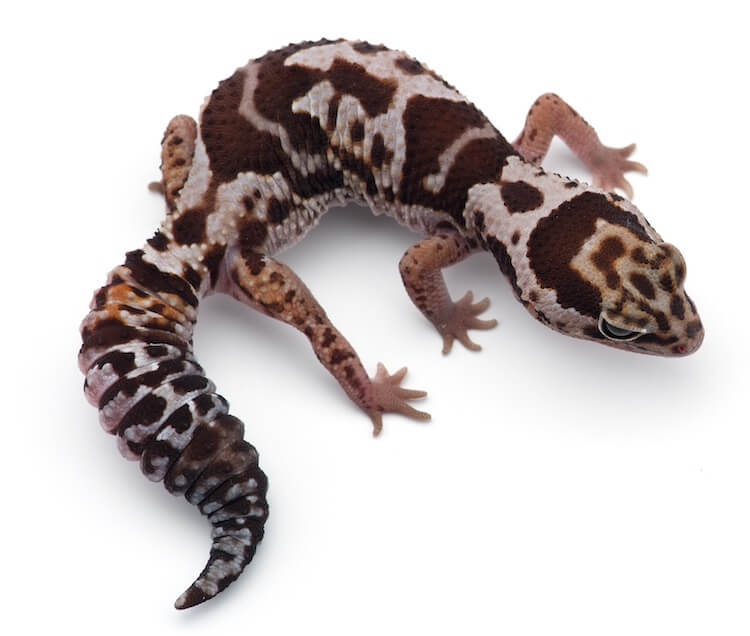
African Fat-Tailed Geckos are a popular breed of Gecko known for their calm temperament and unique patterns.
Originating from the dry region of West Africa, they often spend their nights hiding in humid areas.
Despite closely resembling Leopard Geckos, African Fat-Tailed Geckos are a little smaller and come in fewer color variations.
African Fat-Tailed Geckos have many unique features, one of them being their fat tail. Their tails are so thick because they store extra fat and have a defense mechanism called ‘caudal autotomy’. An ability to lose their tails when threatened or vulnerable.
In captivity, Fat-Tails are known for their docile temperament. They are steadily becoming more popular in the industry and are recommended for novice owners.
Females and males have distinguishing features such as head shape and size, with males being typically larger than females, often reaching between 8-9 inches.
| Lizard Quick Facts | |
|---|---|
| Common Names | Fat-Tailed Gecko |
| Scientific Name | Hemitheconyx caudicinctus |
| Adult Size | 7-9 inches, up-to 45 to 75 grams |
| Lifespan | 10-25 years |
| Diet | Insects |
| Tank Size | 10 gallon + |
| Humidity & Temperature | 75-95°F and humidity should be kept between 50-70% |
| Popular Alternatives | Leopard Gecko |
African Fat-Tailed Gecko Care Guide
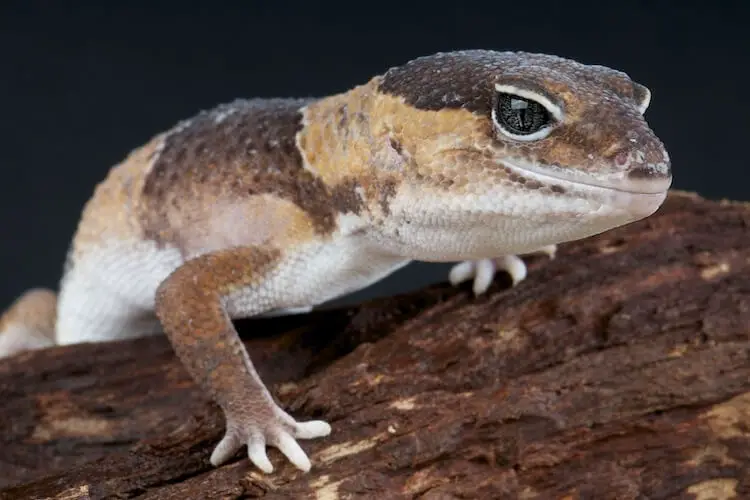
In West Africa, they are found in dry and arid regions. Because of this, African Fat-Tail Geckos often live in very humid hiding holes and are entirely terrestrial.
Fat Tails require an environment that is moderately moist but high in temperature. Their enclosure must have hiding spots and an established heat gradient with a basking spot.
Their captive habitats must therefore have regulated temperatures and lighting, and must have lots of hiding places for these shy lizards
Tank and Enclosure
Wooden vivariums are ideal for African Fat-Tailed Geckos as they are great insulators to maintain the warm environment that the Gecko needs.
Their enclosure should have glass sliding doors and large air vents to maintain a flow of air. Since this reptile won’t grow as much as others, they can live in one enclosure their whole lives. The recommended tank size for hatchlings and adults is 10 gallons.
If you are planning on keeping more pairs of adults together, you should select a 20 gallon-tank or rack system.
Their terrarium should have at least one humid hide for each Gecko, which will need to be placed on the hot side of the tank. It also needs decorations such as cork rounds, logs, grape wood, and bamboo hollows.
Lighting
It is vital that African Fat-Tailed Geckos are exposed to 10-12 hours of light each day. As they do not bask throughout the daytime, they do not need a strong UVB light source (around 5% over a small area).
Either a T8 or a T5 lamp will work for these geckos, and should be mounted to the back of the ceiling, closest to the warmer end, generating a good UV gradient.
African Fat-Tailed Geckos often spend time in the dark, therefore parts of the enclosure should be covered to provides some darkness.
Basking lights should be available during the day to establish a spot of about 90-95 degrees Fahrenheit. The cool side of the tank should drop to the high 70s. These cold-blooded reptiles require a heat gradient in their tank so they can easily moderate their body temperature based on their surroundings.
Heating and Temperature
The temperature of their enclosure should be monitored closely, and should have a hot side of 90-95°F and a cool side of 80°F. This will allow your pet to thermoregulate by moving between the two sides.
Basking lights and under the tank heaters will achieve the high temperatures required.
These lizards need humidity levels to be between 50-70%. Having the right type of substrate, a water bowl and misting the tank daily will ensure you keep their tank humid. Some owners also keep plants in the enclosure to add moisture.
Humid hiding places can be made by placing sphagnum moss underneath a bamboo hollows to ensure it remains damp.
Substrate
A paper substrate works well within an African Fat-Tailed Gecko’s enclosure, such as paper towels or newspaper.
Some owners use a fine orchid bark or a sandy soil mix. Although it is important that sand on its own is not used as a substrate as it can lead to digestion problems and damage their digestive tract.
Using paper will make spot cleaning each day easy, but will need to be changed every 2-3 days. Orchid bark or compressed coconut bedding will only need to be changed weekly.
| Tank Tips | |
|---|---|
| Tank Type | Wooden vivariums |
| Lighting | Basking light |
| Best Substrate | Fine orchid bark |
Feeding
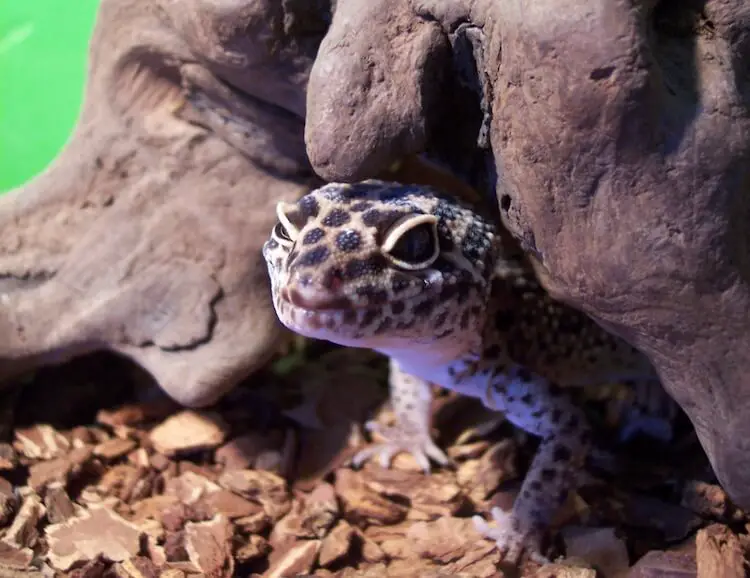
African Fat-Tailed Geckos are carnivorous, and are not known to consume any plant materials in their natural habitat.
Their diet consists mainly of insects and other invertebrates they encounter during the night-time in the savannahs, including different types of worms, crickets and beetles. In captivity, they may only want to eat live prey, but other than that their diet is simple to fulfill.
When kept in captivity, African Fat-Tailed Geckos should be fed crickets and other types of larval insects like mealworms. They will also require additional supplements such as vitamin D3 to help them adapt to a new environment.
Owners can provide these nutrients by either ‘dusting’ the insects with calcium or other vitamin power, or by ‘gut loading’ their feeder insects.
Hatchling, juvenile and adult Geckos only need to eat insects. They can go days without eating because of the extra fat that’s stored in their tails.
African Fat-Tailed Geckos prefer crickets and mealworms. Occasionally they may be offered waxworms, silkworms, hornworms and pinky mice:
- Hatchlings under 4 months should only eat ½ sized crickets and should be fed 5 crickets
- Adults should be fed 9 crickets or worms. Their crickets can be a little bigger (2/3 sized)
Uneaten prey should be removed within a few hours if your Gecko doesn’t eat them.
There should always be a shallow water dish with clean water in their tank, they may not directly drink from it, however it will help retain moisture.
| Diet Summary | |
|---|---|
| Insects | 100% of diet |
| Fruits | 0% of diet |
| Vegetables | 0% of diet |
| Supplements Required | Vitamin D3 and calcium |
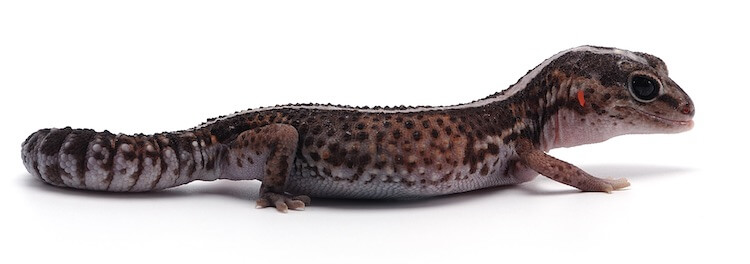
How-To Keep Them Healthy
In the beginning, your African Fat-Tailed Gecko will be shy, you should allow them to settle into their new home for a couple of weeks before you start handling them.
Once your African Fat-Tail Gecko is eating and defecating normally, you can being to handle them.
Many owners find that handling an African Fat-Tailed Gecko is a great experience, as they are very docile and respond well to human contact (without jerking around or trying to escape). To pick them up, your hands must be close to the floor and they will usually walk calmly onto your hands.
An African Fat-Tailed Gecko should never be held by its tail, as it can then feel threatened and detach its tail. However, it will regenerate.
These Geckos are very tame and will rarely bite, however, for the safety of you and your African Fat-Tail Gecko, be gentle and wash your hands before and after handling.
How To Bathe
Generally, bathing is not a necessary procedure, as their skin is cleaned during the shedding process.
Humidity levels in the tank should be enough to help your Gecko shed. If it does have retained skin or is dirty, you are welcome to soak it in a shallow dish with warm water for a few minutes.
A small, shallow tub should be ¼ filled with 50-70°F water, and their feet should be submerged for around 5 minutes. This should not be an everyday activity as these pets do not like being submerged in water.
Tank Cleaning
Their tank should be spot-cleaned every day and deep-cleaned once a month. When cleaning the cage, you should use a reptile-friendly disinfectant spray which should be left for 30 seconds before being wiped away with a paper towel.
During the cleaning process, everything should be removed from the enclosure, including the gecko, decorations and bedding.
You must mist the tank daily, using either a spray or tank humidifier.
Waste should never be allowed to build up as this can cause your reptile to get Cryptosporidiosis. A disease that African Fat-Tailed and Leopard Geckos are susceptible to. To avoid this, clean their feces every day.
Healthy poop will be brown and well-formed. Runny waste may not always indicate illness but a fecal test should take place if it persists.
| Signs They Are Healthy | Sickness Symptoms |
|---|---|
| Movement and interaction with humans and decorations during the day | Strange-colored waste |
| Desire for food and water | Completely inactive during the day |
| They do not lose their tail and are friendly and docile | Complete loss of appetite and Shedding problems e.g. the tail tip is shrivelling |
African Fat-Tailed Gecko Lifespan
Under the right captive conditions, the Fat Tail Gecko may live for up to 25 years.
Relatively healthy lizards, they are at an increased risk for contracting Cryptosporidiosis. If left untreated, this disease can be deadly. Signs will include abnormally runny waste and a very thin tail. Contact a veterinarian if you think your pet is ill.
Behavior and Temperament
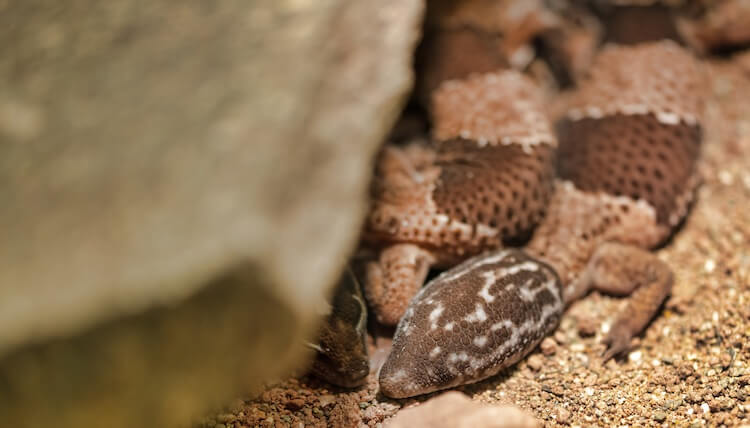
In the wild, and in captivity, African Fat-Tailed Geckos are extremely docile, gentle and calm lizards, who spend their time sleeping, basking and occasionally hunting for insects during the night.
They are unlikely to scratch or bite other animals or humans over food or territory, unless strongly threatened.
Male African Fat-Tailed Geckos vocalize using quiet squeaks and clicks during disputes over territory, to warn off other males, or to attract females, and both sexes will squeak to ward off unwanted company.
When they are hunting, they may raise their tails and wave them in the air, an action that is used to distract the prey before the attack.
They are also known to deceive predators by luring them towards their tails and then detaching it once a predator has grabbed on, running off and leaving the predators to believe they have possession of the Gecko’s head.
In captivity, they will only be active at night and will most likely want to spend their time in hiding holes or basking.
Male Fat Tail Geckos can be housed alone, with a female pair or with multiple females. Females aren’t as defensive which allows them to live in groups. Each Gecko should also have their own hiding hole for privacy and to prevent distress.
During the wintertime, you should allow your Gecko to brumate. Their tank should cool down to about 68-77°F in preparation for spring and males especially should undergo brumation if they are going to breed.
Appearance
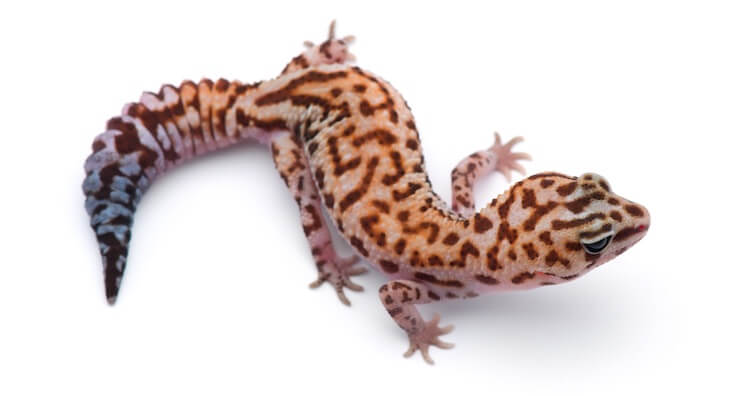
Male and females display sexual dimorphism (i.e. differentiating physical features between the sexes. Males are typically larger than females and will have a thicker tail. They also have preanal pores at the base of their tail whereas females do not.
The African Fat-Tailed Gecko is one of only a few species to have eyelids which prevent dust from entering their eyes.
They also have vertical pupils and no adhesive lamellae, meaning that their feet are not sticky.
Fat Tailed Gecko Size
Hatchlings will be about 2.5-3 inches long and will weigh roughly 4 grams.
These Geckos have a fast growth rate. As fully grown adults they will measure seven to nine inches and will weigh between 45-75 grams. They are similar in size to leopard geckos.
Colors
These unique reptiles are born either one of two forms: banded or striped. Every African Fat-Tailed Gecko has a natural base color of light brown or beige.
Banding stretches down the length of the body, head and tail, and is a dark brown color. They all generally have a white underbelly and some have a white line down their dorsal.
As this species is increasing in popularity, more and more African Fat-Tailed Gecko morphs are becoming available to excited owners. Some of these include a popsicle orange or light gray.
How To Sex Fat-Tailed Geckos
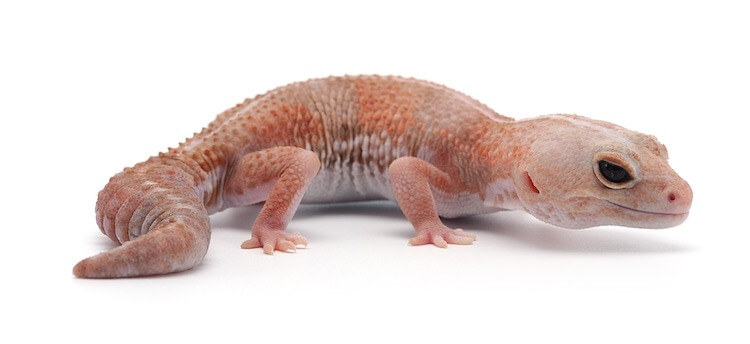
Males attract females by making a clicking sound. When conquering a female, Fat-Tailed Geckos will be vocal. They will make squeaking noises in attempts of attracting a partner.
The mating process begins in November and usually lasts until March.
During mating, the male grabs the female’s neck and holds tightly. The gestation period is usually somewhere between 40 and 70 days and you should be able to notice eggs in the female’s belly. Females will usually have 1-3 offspring per clutch.
If the temperature of the incubation tank is lower, a longer period of gestation will ensue. The recommended incubation temperature is somewhere between 75-90°F; temperatures outside this range will likely be fatal.
Baby African Fat-Tailed Geckos
Babies are identical to adult Geckos in everything except size. Hatchlings will be about 2.5 inches long, weighing just 4 grams.
They reach maturity around 8-11 months after hatching. They should be kept in a small enclosure with plenty of hiding spots to make them feel at home. They should only be fed small insects that they are able to digest.
How Much Do African Fat-Tailed Geckos Cost?
Prices can be as low as $75 or as high as $500 USD based largely on its appearance and breeder!
African Fat-Tailed Geckos are becoming increasingly popular and are a very modern reptile so they won’t be at local pet stores. These Geckos can be found through my online breeders instead. Because there are many beautiful and unique morphs available, the prices will vary.
Care Guide Summary
| Pros | Cons |
|---|---|
| Attractive and unique patterns make them fascinating to watch | They struggle in cold temperatures, so the heat of their tank must be closely regulated |
| Docile and open to being handled so make good beginner reptiles | They can be picky with the insects they eat |
| Are widely available to be purchased from breeders | They can be shy when young, making it harder for owners to interact with them |
African Fat-Tails are commonly compared to the more popular Leopard Gecko. They are alike in so many ways, such as temperament, appearance, and care requirements. The main difference between is the African Fat-Tails’ shy personality.
Once you have set-up their tank correctly, the African Fat-Tailed Gecko is not difficult to care for.
The most important things to consider is that they have a healthy diet of live insects and that their cage is cleaned regularly to avoid illness.
Due to their calm and docile nature, these Geckos are recommended for all reptile lovers, especially beginners.
Their unique markings and communicative noises make them fascinating creatures to watch, and their ability to be held calmly by adults and children makes them family-friendly pets!
African Fat-Tailed Geckos are loved for their endearing “smile”, bashfulness and acceptance to handling.
Let us know what you think about the African Fat-Tail Gecko below.

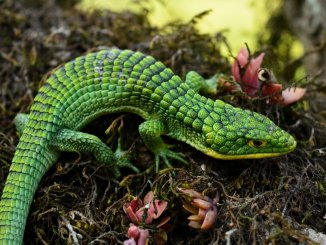
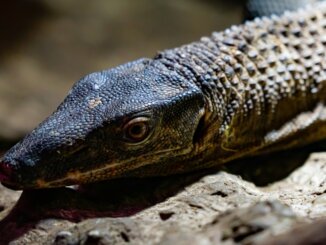
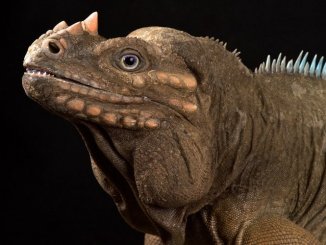
I have 1 fattail and 2 leopard geckos. I love them! My fattail will go after the crickets but when I offer mealworms the he will turn his head away and the 2 leopards eat them up. The fattail is doing and looking very well but doesn’t seem to like the mealworms.
Do not house leopard geckos and fat tails together. Get them all in their own tanks, especially the fat tail. They are different species and require different humidity levels.
My AFT dont care for meal worms neither. He tried a small Dubia Roach the other day and seemed to like it other than that so far he seems to only like crickets. Ill be introducing new bugs as we go. If he wont eat them my Beardie definitely will lol.
I’ve been considering getting a gecko, the African Fat-Tailed and the Gargoyle Geckos captured my attention. What are the pros and cons of getting each of them. I read that Gargoyles like to jump and can be very active and difficult to handle. What happens if the African Fat-Tailed gets scared – do they lose their tails? Thank you for any contribution.
Hi Alex, both are great choices for beginners. The African Fat-Tailed will be shier and Gargoyles are jumpy – but this will calm down after their juvenile phase. In our article on the best lizards for beginners we compare all three (including the leopard) so that will provide you with the pros and cons of each. Good luck.
The gargoyle is almost just like a crested gecko, probably the 2nd most popular lizard. They need at least a 18 by 18 by 24 inch tank, and rotating humidity at 80 down to 50, this is most easily done by a small spray in morning and completely spraying it down before bed. They eat the same as a crested gecko because they live together in the wild. Please don’t put them together in a tank as it’s not safe.
My son has had his fat tail for about three weeks and she is really docile. But tonight she bit him. Just out of the blue. She is shedding. Does that have anything to do with it? She had never done that before, we just want to make sure that we weren’t doing something wrong.
Hi Michelle, yes you are right. Give her time to completely shed before attempting to disturb or handle her again.
Shedding geckos are very scared because they think your taking advantage of their vulnerability.
My aft doesn’t seem to care what insect you give him, if he moves, he’ll eat it. i don’t think he even chews he just bites and swallows and he’s ready for the next one. my leo takes a little more time and seems more picky than him, she seems more focused and calculated about how she’s gonna get it whereas he’s more IS THAT FOOD GIVE IT TO ME
Had my gecko for 6 months she always eats great her heat mat broke so she got cold and sluggish got her back to her perky self and warm but nearly 2 weeks and not eaten she has pooed since but last poo was a bit green and watery can any one help me what wrong with her going to phone the vet on Monday very worried
Green poop is not a good sign, but it is not easy to determine the cause. It could be anything from substrate injection to parasite infection or other digestive issues. Have you recently switched her diet?
Keep in mind that you can collect the poop and bring it to the vet for him to analyze without having to move your gecko.
Hi, i am a beginner and im just learning about the fat tailed gecko and this is so helpful! if i could rate this i would give it a 5/5
Same 😁